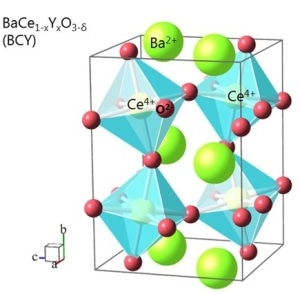Jun 23 2017
Researchers believe hydrogen will be the prospective energy source in the future. Hydrogen is synthesized by using solar power and can be used to produce electricity and heat in fuel cells. At present, Scientists at Empa have been successful in deciphering the movement of hydrogen ions in crystals.
This success is perceived to be a significant step forward in the efficient conversion of energy in futuristic hydrogen industries.
 The experiments have been conducted with Barium ceric oxide. The crystal is non conductive in a dry state. When moisture comes in, the protons form OH-bondings and move through the crystal. (Credit: Empa)
The experiments have been conducted with Barium ceric oxide. The crystal is non conductive in a dry state. When moisture comes in, the protons form OH-bondings and move through the crystal. (Credit: Empa)
Ions and electrons are charge carriers that have a vital role in electrochemical energy storage devices as well as converters like fuel cells and batteries. In the case of converters, proton conductivity is highly important. Protons, or positively charged hydrogen ions, are made of hydrogen that is used to power up the fuel cell. Artur Braun, Physicist at Empa and Qianli Chen, a Doctoral Student at ETH Zurich, performed neutron scattering experiments on the Swiss Spallation Neutron Source (SINQ) at the Paul Scherrer Institute (PSI) and documented proton movement in the crystal lattice. During this procedure, they noticed that the movement of protons in ceramic fuel cells was in accordance with far more complex laws than presumed earlier—the proton movement obeys the well-known polaron model, which the Researchers have described recently in Nature Communications, a prominent journal.
For a long tme, the polaron theory proposed by Lev Davidovich Landau, a Russian Physicist and an eventual Nobel Prize Winner in the year 1933, applied only to electrons. The model outlines the way in which electrons “worm” their path through a dielectric crystal and throw the “interfering” out of place, resulting in the reduction in velocity of the electrons. Put differently, polarons are waves of motion in the crystal. The proliferation of these waves can be termed as a particle’s trajectory, where the waves can get reflected and deflected.
The electron polaron has long been the foundation of theoretical physics and the unquestionable fundamentals that Research Experts use for applied model calculations. On the contrary, the occurrence of a hydrogen polaron, or a hydrogen ion “hopping” from one place to another, was only a theoretical notion till date. Despite the fact that biologists have applied the hopping hydrogen model to describe specific metabolic processes, hydrogen polaron was not considered to be a reasonable illustrative model by solid-state physicists.
However, there are chances that this notion can be altered at the moment: By conducting experiments with barium zirconium oxide and yttrium-doped barium ceric oxide crystals, Braun and Chen were able to prove the presence of proton polaron. Under dry conditions, these crystals remain non-conductive. However, when they come into contact with a steam atmosphere, OH groups are formed inside the crystal structure. The liberated protons are now free to move in a wavelike manner, and thus the oxide turns ionically conductive.
Heat and high pressure provide proof
Braun and Chen found verified evidence of hydrogen ion waves by investigating the crystals at temperatures of nearly 600°C and under different high-pressure conditions. Empa’s prized association with the wider scientific community played a crucial part: PSI’s neutron source was used for taking x-rays of the samples, and Scientists at the Faculty of Geosciences/Geography at Goethe University, Frankfurt am Main, collaborated with Empa Researchers to perform high-pressure experiments on the crystals.
The outcome of the research is that the conductivity increased to accurately the same degree as proposed in model calculations for the lattice vibrations of the crystal, at temperatures of 220°C to 520°C. Hence at first, when heated, the protons are bound to the crystal lattice and start hopping via the crystal from one OH group to the other congruous to the lattice vibrations. When a special compactor is used to exert high pressure to the crystal, there is less room for the proton to hop, resulting in a drop in conductivity. From this, it can be understood that the polaron model is applicable not only to electrons but also to protons.
And who knows, perhaps the theory also holds true for other ions such as lithium.
Artur Braun, Physicist, Empa
The outcomes of the study by the Empa Scientists can soon produce crucial information on the selection of materials hydrogen storage systems as well as fuel cells, thus having a positive impact on futuristic energy supply. Moreover, the functioning of ceramic insulators can also be efficiently calculated at present: Do the insulators insulate in a better way under high-temperature conditions in the humid ambient air? Or do current leakages occur as a result of polaron conduction? Braun and Chen’s research has been thus able to answer specific paradoxes in the field of Material Science. The Swiss National Science Foundation (SNSF) funded this study.